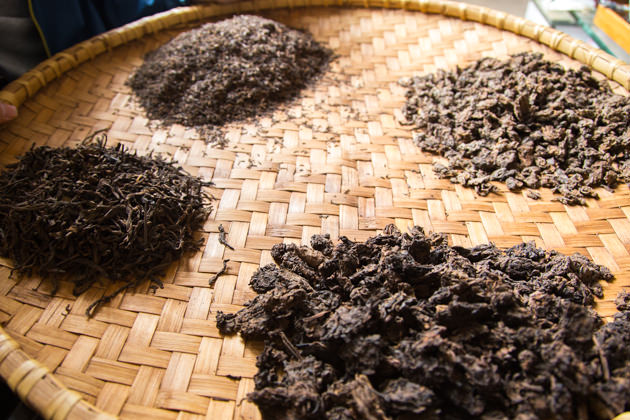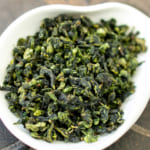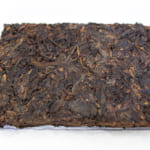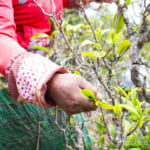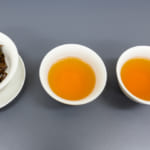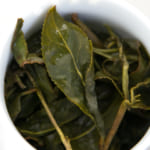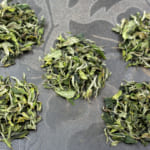- HOME >
- New Arrival at HOJO Online Shop
New Release of Cha Tou Ripe Pu-erh Tea 2015
- [2017.02.24] Posted By Akira Hojo
We purchased Cha Tou 2015 when we visited Yunnan in 2016. This tea was produced in the village located about 50km away from the Myanmar border. The tea was grown with the natural farming method which no pesticide or fertilizer is used.
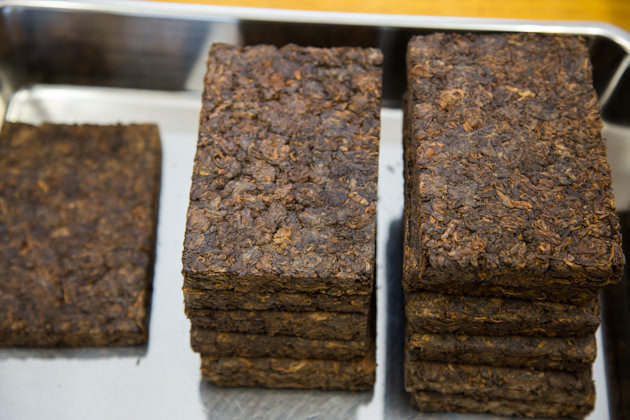
Even after the compression we still can observe the Cha Tou
Cha Tou is the lumps of tea produced by microorganism during tea fermentation
Cha Tou means “the head of tea” in both Chinese and Japanese. Technically, Cha Tou is the lumps of tealeaf coagulated during the fermentation due to the polysaccharide produced by the microorganism. There is no oxygen inside Cha Tou. Because of this fact, it undergoes very unique maturation during the process.
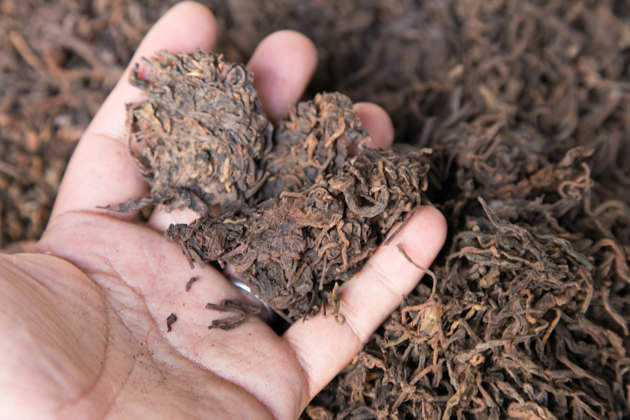

Small Cha Tou
Small Cha Tou
There are two types of Cha Tou: the big Cha Tou and the small Cha Tou. Sometimes the tea manufacturer even classifies it into three categories. They may have mini Cha Tou as well. We used big Cha Tou for our earlier lineup, the Cha Tou Ripe Pu-erh 2012. However, we selected small Cha Tou for 2015 crop. The size of the small Cha Tou is about 1cm or slightly bigger.

It is extremely rare to make ripe pu-erh tea from spring tea
The majority of the ripe pu-erh tea is produced after blending all batches of tea collected in late spring, summer and autumn tea. The manufacturer conducts blending in order to even out the price and the overall quality. This is the typical production style of ripe pu-erh tea in big factory with mass production scale.
In other words, it’s extremely rare to find ripe pu-erh tea produced from only spring tealeaf in commercial tea market. If you have ever tried the ripe pu-erh tea produced from the spring crop, there is a huge difference in quality compared to the blended tea. The spring tea gives a mellow and silky soft drinking sensation with long lasting sweetish aftertaste.
Our tea is always from the spring crop. Every year we visit the tea manufacturer in early spring to look for the spring tea.

Ripe pu-erh tea was invented in 1970s. It has a very short history as compared to the raw pu-erh tea that has more than 700 years of history. However, in oversea market, a lot of people associate ripe pu-erh tea as the “pu-erh tea”. The ripe pu-erh tea is produced by the microbiological fermentation. During the fermentation, the substance that gives astringency such as EGCg is being oxidized and decomposed.
If tea is produced from early spring crop, regardless of raw or ripe pu-erh tea there is no astringency. On the other hand, if raw pu-erh tea is produced from summer tea, it gives strong astringency. However, once the summer tea is fermented into the ripe pu-erh tea, it gives no astringency thanks to the reason mentioned above. Consequently, summer tea-based ripe pu-erh tea is well accepted and often more famous than raw pu-erh tea in oversea market.
Earthy smell is due to the failure of process management
Many people commented that ripe pu-erh tea tends to give earthy flavor like old furniture smell or soil. This type of smell is called camphor smell that gives impression like traditional Chinese medicine. In fact, this smell is developed if ripe pu-erh tea is not produced in a proper manner. It is due to the failure in fermentation.
There are a number of microorganisms that involves in the fermentation of ripe pu-erh tea. Usually the anaerobic and aerobic bacteria actively involved in the initial stage and subsequently it is taken placed by the yeast and mold. However, if too much water is being applied, tea leaves are over wet and there is insufficient oxygen. As a result, anaerobic bacteria dominate the fermentation and it will produce substances that give unpleasant smell.
We never purchase tea once we detect camphor smell. Unfortunately, a lot of pu-erh teas are poorly made and gives earthy smell. That is the reason why a lot of people have negative impression with ripe pu-erh tea. The well-produced ripe pu-erh tea gives sweet dry-fruity flavor.
Aging further enhances the flavor of Cha Tou
The Cha Tou is giving a mild sweet fruity flavor even if tea is still fresh.
However, the best timing to drink this tea is after being kept for a few years (if tea is kept in warmer climate. In case the tea is kept under cooler environment, the maturation will takes longer period of time).
It develops very unique and complex flavor like dried dates with a hint of raisin note.
Related Articles
How to get the latest update on HOJO Tea?
1. Follow Twitter, 2. Click "Like" on Facebook, and 3. Subscribe in newsletter. You can have the latest tea news from HOJO Tea.
 Subscribe the Newsletter to enjoy the privileges
Subscribe the Newsletter to enjoy the privileges- You may receive a free sample upon purchase, or you may have the priority to purchase special products. So please remember to subscribe our newsletter as well as the social network.
- New Release of Lan Yun Tie Guan Yin from Anxi
- Lan Yun Tie Guan Yin from Anxi, is not just an ordinary Tie Guan Yin. It has a strikingly delightful flavor reminiscent of orchid flowers with silky-soft drinking sensation. Anxi, renowned as one of the three major Oolong tea production regions in China. Anxi is recognized as one of the three major Oolong tea-producing regions …
- The new release of Bao Dao Shan Da Cha Tou Brick 2017, exclusively crafted from Da Cha Tou leaves
- Bao Dao Shan Cha Tou Zhuan 2017 is a ripe pu-erh tea crafted into brick form. Bao Dao Shan is the name of the mountain situated in the southwestern part of Yunnan. “Cha Tou” denotes a distinctive type of ripe pu-erh tea. In the course of fermenting spring tea, certain tea clumps naturally develop, known …
NEW ARTICLES
 Yunnan 2024 Spring Tea Sourcing
Yunnan 2024 Spring Tea Sourcing- Yunnan Province is globally renowned for the exceptional quality of its tea leaves. However, lax production management often presents challenges in achieving the desired tea quality when relying solely on pre-made teas. To address this issue, we have committed to remaining on-site throughout the spring season to closely monitor tea production. We are meticulously inspecting …
 The Relationship Between Greenness of Tea Leaves and Fertilizer
The Relationship Between Greenness of Tea Leaves and Fertilizer- For both tea and vegetables, there’s a common misconception that a deeper green colour indicates better quality and greater health benefits. However, this isn’t always the case. Natural plants often have a yellowish-green hue rather than a vibrant green. If you observe wild plants in grasslands or along roadsides during spring, you’ll notice that they …
 Creating Muscatel Black Tea Using a Unique Blending Method
Creating Muscatel Black Tea Using a Unique Blending Method- I would like to introduce the unique creation of black tea with a distinctive muscatel flavor profile. Acquiring Exceptional Mi Xiang Black Tea Have you ever heard of a unique black tea called “Mi Xiang Black Tea” or “Muscatel Black Tea”? This tea is crafted from leaves that have been delicately nibbled by leafhoppers, resulting …
 New Release of Lan Yun Tie Guan Yin from Anxi
New Release of Lan Yun Tie Guan Yin from Anxi- Lan Yun Tie Guan Yin from Anxi, is not just an ordinary Tie Guan Yin. It has a strikingly delightful flavor reminiscent of orchid flowers with silky-soft drinking sensation. Anxi, renowned as one of the three major Oolong tea production regions in China. Anxi is recognized as one of the three major Oolong tea-producing regions …
 The Difference Between Fermentation in Tea and Fermented Foods
The Difference Between Fermentation in Tea and Fermented Foods- Black tea and oolong tea are often categorized as “fermented teas,” but the extent to which they undergo fermentation raises questions about whether they truly qualify as fermented foods. In this article, I endeavour to offer a thorough exploration of the distinctions between tea and traditional fermented foods, shedding light on the nuances of their …
 Easy Way to Prepare Flavorful and Warm Tea at the Workplace
Easy Way to Prepare Flavorful and Warm Tea at the Workplace- Have you ever experienced the transformation of tea stored in a thermos or water bottle at work, turning into a brown hue and acquiring a bitter, astringent taste? As this has piqued the interest of many, I would like to offer a more in-depth explanation for a solution. Tea stored in a thermos undergoes oxidation …
 The new release of Bao Dao Shan Da Cha Tou Brick 2017, exclusively crafted from Da Cha Tou leaves
The new release of Bao Dao Shan Da Cha Tou Brick 2017, exclusively crafted from Da Cha Tou leaves- Bao Dao Shan Cha Tou Zhuan 2017 is a ripe pu-erh tea crafted into brick form. Bao Dao Shan is the name of the mountain situated in the southwestern part of Yunnan. “Cha Tou” denotes a distinctive type of ripe pu-erh tea. In the course of fermenting spring tea, certain tea clumps naturally develop, known …
 We released Lapsang Suchong Qi Zhong Classic: Premium Lapsang Souchong
We released Lapsang Suchong Qi Zhong Classic: Premium Lapsang Souchong- Lapsang Souchong is one of the earliest known black teas distinguished by a unique production method and flavour profile. Its origins are often linked to the Wuyi Mountains in China’s Fujian province, where Lapsang Souchong is traditionally crafted. Black tea production in the Wuyi region has a history dating back several centuries. Lapsang Souchong tea …
 Regular Consumption of Umami Seasoning Can Influence Taste Preferences
Regular Consumption of Umami Seasoning Can Influence Taste Preferences- Excessive consumption of artificial condiments, such as umami seasonings, is believed to influence one’s taste and preferences. I’d like to share my own view to explore how an overabundance of condiments can indeed influence one’s palate. Umami Seasonings Are Prevalent in Asian Countries I spend half of the year living abroad, particularly in China and …
 Special Release Limited Set of Ancient White Tea from 5 Gardens
Special Release Limited Set of Ancient White Tea from 5 Gardens- The ancient white tea is a very popular tea in our store. We produced this tea in spring. Following production, it was stored in an oxygen-free environment for several months to further enhance its flavor, achieving the expected maturation. The production of ancient tree white tea is limited in quantity per day, resulting in small …
Shop Info

Address:Lot No. T-215, 3rd Floor, The Gardens Mall, Mid Valley City, Lingkaran Syed Putra, 59200 Kuala Lumpur
Tel: +603-2287-4537
Business Hour: 10am to 10pm
Category
- New Arrival at HOJO Online Shop
- Featured Articles
- Newsletter
- Types of Tea
- Origin of Tea
- Teapot and Tea Equipment
- Tea Column
- How to enjoy tea
- Tea Processing
- How to choose quality tea
- Tea constituents and functional effect
- Safety of Tea
- Foods
- Tea Business Operation
- Hobby and Outdoor Activity
- Ranking of Tea
- Video
- FAQ
- Media Release
Profile

- AKIRA HOJO
- I invite you to experience my tea selections.I was born in Nagano, Japan. In university, I studied agricultural chemistry, and I have the master degree in food science. I worked in Japanese food industry for 10 years. I involved in R&D, QC and QA. As a factory manager, I implemented ISO9000 series and managed the factory.
- The Art of Tea Magazine
- We posted the article on “The Art of Tea Magazine No.9, the magazine is published in Taiwan. We featured some scientific view about the tetsubin
- New Straits Times
- The Malaysian National Newspaper, New Straits Times featured HOJO Tea on 17-Oct-2007.



